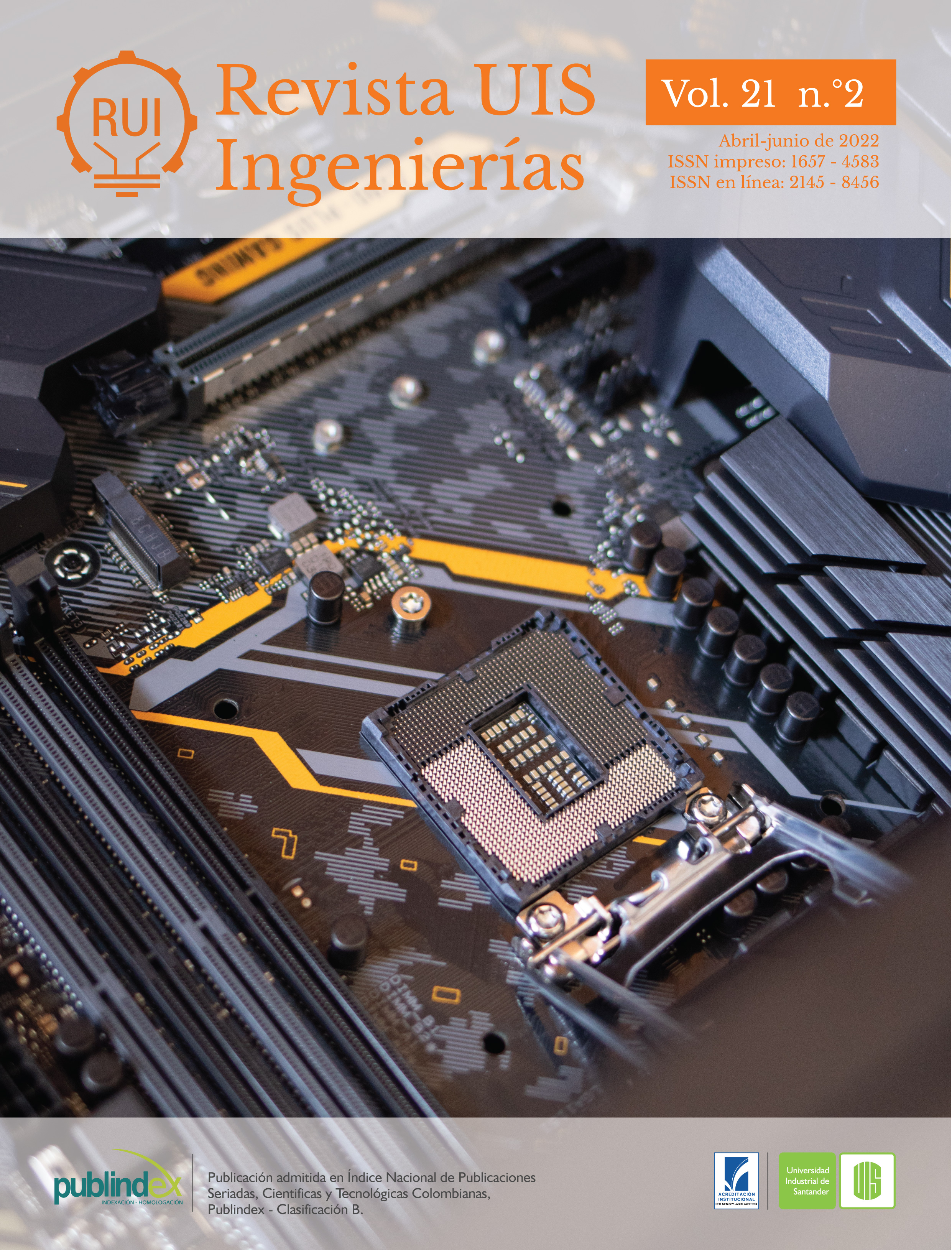Published 2022-04-06
Keywords
- harvest planning,
- distribution,
- perishable products,
- decision making,
- supply chain
How to Cite
Copyright (c) 2022 Revista UIS Ingenierías

This work is licensed under a Creative Commons Attribution-NoDerivatives 4.0 International License.
Abstract
A production planning problem related to income is addressed in a fruit supply chain of small producers, who prefer not to harvest if the market price does not allow their costs to be recovered. A mathematical model is proposed to represent the harvest decision where three elements are considered: the product perishability, the market prices behavior, and finally how much to harvest. This paper establishes that the income improvement of small agricultural producers is a strategy to support the socio-economic development of this sector. The model applied in a small citrus producer’s case study show that adequate harvest planning allows establishing a relationship between prices and sales to maximize small producer profits.
Downloads
References
- “Commodities and Development Report 2015 - Smallholder Farmers and Sustainable Commodity Development,” United Nations Conference on Trade and Development, Tech. Rep.UNCTAD/SUC/2014/5, 2015 [Online]. Available: https://unctad.org/system/files/official-document/suc2014d5_en.pdf
- G. Rapsomanikis, “The economic lives of smallholder farmers: An analysis based on household data from nine countries,” Food and Agriculture Organization of the United Nations, Roma, FAO Tech. Rep, 2015 [Online]. Available: https://www.fao.org/3/i5251e/i5251e.pdf
- R. Christen, J. Anderson, “Segmentación de hogares de pequeños agricultores: Cómo satisfacer el abanico de necesidades financieras de las familias agricultoras”, Enfoques, no. 85, 2013[Online]. Available: https://www.cgap.org/sites/default/files/Focus-Note-Segmentation-of-Smallholder-Households-April-2013-Spanish.pdf
- R. Young, P. Esqueda, “Vulnerabilidad de la cadena de suministro: consideraciones para el caso de América Latina,” Academia. Revista Latinoamericana de administración, no. 34, 63-78, 2005.
- R. Ballou, Logística, administración de la cadena de suministro. USA: Pearson. Prentice-Hall, 2004.
- S. Chopra, P. Meindl, Administración de la cadena de suministro. México: Pearson Education, Inc, 2013.
- S. H. Huan, S. K. Sheoran, G. Wang, “A review and analysis of supply chain operations reference (SCOR) model,” Supply Chain Management, vol. 9 no. 1, pp. 23-29, 2004, doi: https://doi.org/10.1108/13598540410517557
- R. Terrazas Pastor, “Planificación y programación de operaciones,” Revista Perspectivas, vol. 28, pp. 7-32, 2011.
- J. C. Osorio, T. G. Motoa, “Planificación jerárquica de la producción en un job shop flexible”, Revista Facultad de Ingeniería, vol. 44, pp.158-171, 2014.
- J. J. Bastidas, Optimización de decisiones empresa-riales: principios de descomposición, jerarquización y dualidad. Col: Editorial Universidad del Valle, (2013).
- C. T. Zhang, L. P. Liu, “Research on coordination mechanism in three-level green supply chain under non-cooperative game,” Applied Mathematical Modelling, vo. 37, no. 5, 3369-3379, 2013, doi: https://doi.org/10.1016/j.apm.2012.08.006
- O. Ahumada, J. R. & Villalobos, “Operational model for planning the harvest and distribution of perishable agricultural products,” International Journal of Production Economics, vol. 133, no. 2, pp. 677-687, 2011, doi: https://doi.org/10.1016/j.ijpe.2011.05.015
- W. Zhang, W. E. Wilhelm, “OR/MS decision support models for the specialty crops industry: a literature review,” Annals of Operations Research, vol. 190, no. 1, pp. 131-148, 2009, doi: https://doi.org/10.1007/s10479-009-0626-0
- R. A. Broekmeulen, “Operations management of distribution centers for vegetables and fruits,” International Transactions in Operational Research, vol. 5, no. 6, pp. 501-508, 2006, doi: https://doi.org/10.1111/j.1475-3995.1998.tb00132.x
- M. Blanco, G. Masini, N. Petracci, J. A. Bandoni, “Operations management of a packaging plant in the fruit industry,” Journal of Food Engineering, vol. 70, pp. 299–307, 2005, doi: https://doi.org/10.1016/j.jfoodeng.2004.05.075
- F. G. Ortmann, J. H. Van Vuuren, F. E.Van Dyk, “Modelling the South African fruit export infrastructure: A case study,” ORION, vol. 22, no. 1, pp.35-57, 2006, doi: https://doi.org/10.5784/22-1-32
- S. Jena, M. Poggi, “Harvest planning in the Brazilian sugar cane industry via mixed integer programming,” European Journal of Operational Research, vol. 230, no. 2, pp. 374-384, doi: https://doi.org/10.1016/j.ejor.2013.04.011
- C. Herrera-Cáceres, F. Pérez-Galarce, E. Álvarez-Miranda, A. Candia-Véjar, “Optimization of the harvest planning in the olive oil production: A case study in Chile,” Computers and Electronics in Agriculture, vol. 141, pp. 147-159, 2017, doi: https://doi.org/10.1016/j.compag.2017.07.017
- E. López Milán, S, M, Fernández, L. M. Aragonés, “Sugar cane transportation in Cuba, a case study,” European Journal of Operational Research, vol. 174, no. 1, pp. 374–386, 2006, doi: https://doi.org/10.1016/j.ejor.2005.01.028
- J. K. Gigler, E. M. T. Hendrix R. A. Heesen, V. G. W. van den Hazelkamp, G.Meerdink, “On optimization of agri chains by dynamic programming,” Eur. J. Oper. Res., vol. 139, no. 3, pp. 613–625, 2002, doi: https://doi.org/10.1016/S0377-2217(01)00191-6
- Z. Viancha, “Modelos y configuraciones de cadenas de suministro en productos perecederos,” Ingeniería y desarrollo, vol. 32, no. 1, 2014, doi: https://doi.org/10.14482/inde.32.1.4577
- B. H. Nagaratnam, M. E. Rahman, A. K. Mirasa, M. A. Mannan, S. O. Lame, “ Workability and heat of hydration of self-compacting concrete incorporating agro-industrial waste,” Journal of Cleaner Production, vol. 112, pp. 882-894, 2016, doi: https://doi.org/10.1016/j.jclepro.2015.05.112
- V. Salin, “Information technology in agri-food supply chains,” Int. Food Agribus. Manag. Rev., vol. 1, no. 3, pp. 329–334, 1998, doi: https://doi.org/10.1016/S1096-7508(99)80003-2
- H. Tsubone, R. Muramatsu, M. Soshiroda, “Designing an effective production system for processing agricultural products,” Int. J. Prod. Res., vol. 21, no. 1, pp. 17–30, 1983, doi: https://doi.org/10.1080/00207548308942333
- J. H. Dorfman, A. Havenner, “State-space modeling of cyclical supply, seasonal demand, and agricultural inventories,” American Journal of Agricultural Economics, vol. 73, no. 3, pp. 829–840, 1991, doi: https://doi.org/10.2307/1242835

